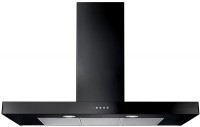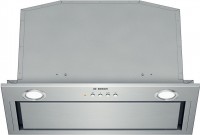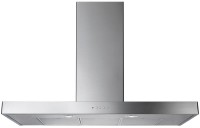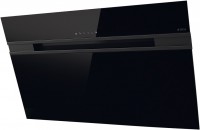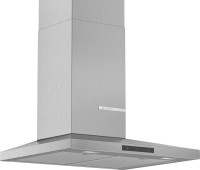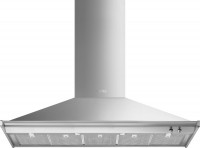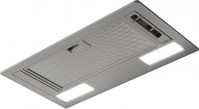Cooker Hoods Franke dome
All Cooker Hoods Advanced filters → |
You might be interested in
Articles, reviews, useful tips
All materials
How to choose a cooker hood
Secrets of choosing a cooker hood that will fit all parameters and last for many years

How to clean the hood
It is important not only the external cleanliness and attractiveness of the hood, but also the condition of its internal parts.
Cooker Hoods: specifications, types
Show all
Product type
— Traditional (wall). Free-standing (non-embedded) wall-mounted units. The most common type of modern hoods: hobs are often placed near the walls, and it also makes sense to install the hood there.
— Wall/built-in. This type includes exclusively visor hoods(see below), which can be installed both as wall-mounted and built-in.
— Built-in (in cabinet). Hoods mounted in a kitch...en cabinet; only the duct panel remains outside. It can be fully built-in or have a sliding panel; see "Design" for details. Nevertheless, the built-in hood is almost entirely hidden inside the cabinet, making it easier to fit into the overall kitchen design than a stand-alone one.
— Island (ceiling). Hoods mounted on the ceiling. The advantage of such devices is that they can be installed anywhere in the kitchen, not necessarily against the wall. If the hob is placed not against the wall but in the middle of the kitchen, such a hood can be indispensable.
— Suspended (ceiling). Hood models that are as similar as possible to island hoods differ in the type of installation — they use special cables that hold the device under the ceiling (something similar to hanging chandeliers). And, due to the distance from the wall (ceiling), such hoods work on the principle of recirculation, air extraction is not typical for them.
— Built-in (ceiling). A type of built-in hood mounted on the ceiling — usually between the suspended and the main ceiling. Such models are distinguished by their large size and high performance; they are intended not so much for the "maintenance" of individual cooking hobs but for general ventilation of the premises. Also, note that the installation of such hoods has to be planned already at the stage of the initial design of the premises.
— Corner (wall). Hoods designed for installation in a corner. In some cases, it is this installation of the cooker (and hood) that is the best option. In general, such devices are similar to the wall-mounted ones described above.
— Downdraft (built into tabletop). A variety of built-in hoods designed to be built into the countertop. Usually, they are equipped with a retractable air intake, which, when opened, moves upwards, and when not in use, it is hidden inside the countertop and does not interfere with its use.
— Wall/built-in. This type includes exclusively visor hoods(see below), which can be installed both as wall-mounted and built-in.
— Built-in (in cabinet). Hoods mounted in a kitch...en cabinet; only the duct panel remains outside. It can be fully built-in or have a sliding panel; see "Design" for details. Nevertheless, the built-in hood is almost entirely hidden inside the cabinet, making it easier to fit into the overall kitchen design than a stand-alone one.
— Island (ceiling). Hoods mounted on the ceiling. The advantage of such devices is that they can be installed anywhere in the kitchen, not necessarily against the wall. If the hob is placed not against the wall but in the middle of the kitchen, such a hood can be indispensable.
— Suspended (ceiling). Hood models that are as similar as possible to island hoods differ in the type of installation — they use special cables that hold the device under the ceiling (something similar to hanging chandeliers). And, due to the distance from the wall (ceiling), such hoods work on the principle of recirculation, air extraction is not typical for them.
— Built-in (ceiling). A type of built-in hood mounted on the ceiling — usually between the suspended and the main ceiling. Such models are distinguished by their large size and high performance; they are intended not so much for the "maintenance" of individual cooking hobs but for general ventilation of the premises. Also, note that the installation of such hoods has to be planned already at the stage of the initial design of the premises.
— Corner (wall). Hoods designed for installation in a corner. In some cases, it is this installation of the cooker (and hood) that is the best option. In general, such devices are similar to the wall-mounted ones described above.
— Downdraft (built into tabletop). A variety of built-in hoods designed to be built into the countertop. Usually, they are equipped with a retractable air intake, which, when opened, moves upwards, and when not in use, it is hidden inside the countertop and does not interfere with its use.
Design
— Dome. Hood with a round or rectangular air duct; in the lower part turning into a conical or trapezoidal body. Usually, it has a discreet design with a minimum number of decorative elements. Exceptions to this rule apply to country style, shown separately.
— T-shaped. Outwardly, it resembles a dome hood, but instead of a conical or trapezoidal body, the air duct ends with a flat rect...angular air intake. In cross-section, the system resembles the letter "T" for which it got its name.
— Angled. In such hoods, the air intake panel is installed at an angle to the duct. This design is purely aesthetic and does not affect functionality.
— Vertical panel. A special type of wall-mounted hood that is as close as possible to angled models, except that when not in use, the front panel is parallel to the wall and not at an angle.
— Cylindrical. Classic cylindrical hoods.
— Rectangular. Hoods of an even geometric shape of a solid design and do not have a division into a duct and a body (as is done in T-shaped models).
— With glass. The main distinguishing feature of all such hoods is the presence of a glass plate in the design as an additional decorative element. The very appearance of the hood can be anything: dome with glass, T-shaped with glass, angled with glass, cylindrical with glass.
— Visor. Extractor hood designed for installation under a kitchen cabinet. At the same time, the air duct is hidden inside, and outside there is only a flat air intake resembling a visor (hence the name). Glass is often used in the design of the visor.
— Sliding panel. As the name implies, these hoods are equipped with a retractable air intake panel. During operation, the panel opens — thus increasing the effective suction area. The hood itself is usually built into a cabinet or table (see "Product type"). But this type can be implemented in two ways. Sliding hoods with open panel when closed have a front panel that stands out and is visible under the cabinet. Sliding hoods with hidden panel are not visible when closed, and the opening mechanism is designed in such a way that the panel extends slightly at an angle.
— Fully built-in. Hoods that are built-in in the full sense of the word: the device is almost entirely hidden in a hanging cabinet or ceiling; only the air intake panel is outside. Such an installation is known by a minimum of visible details and allows you not to worry about how the hood will fit into the kitchen interior.
— Modern (unusual design). Hoods with a hi-tech look — using polished metal, glass and a minimum of decorative elements. Most modern style hoods have a specific design that does not fit into any of the options described above; Therefore, they are separated into a separate category. However, the design of such devices may vary; there are both absolutely minimalistic and rather pretentious, original design.
— Country. Country-style hoods usually have light, soft body colours (white, beige, light grey) and structural elements decorated in wood, bronze and other similar materials. By design, such devices are usually similar to domed ones. Note that with similar performance, country hoods are noticeably more expensive than conventional style models. In addition, they are quite demanding on the environment: the whole kitchen must be made in a similar style. otherwise, it is likely that the device simply does not fit into the interior.
— T-shaped. Outwardly, it resembles a dome hood, but instead of a conical or trapezoidal body, the air duct ends with a flat rect...angular air intake. In cross-section, the system resembles the letter "T" for which it got its name.
— Angled. In such hoods, the air intake panel is installed at an angle to the duct. This design is purely aesthetic and does not affect functionality.
— Vertical panel. A special type of wall-mounted hood that is as close as possible to angled models, except that when not in use, the front panel is parallel to the wall and not at an angle.
— Cylindrical. Classic cylindrical hoods.
— Rectangular. Hoods of an even geometric shape of a solid design and do not have a division into a duct and a body (as is done in T-shaped models).
— With glass. The main distinguishing feature of all such hoods is the presence of a glass plate in the design as an additional decorative element. The very appearance of the hood can be anything: dome with glass, T-shaped with glass, angled with glass, cylindrical with glass.
— Visor. Extractor hood designed for installation under a kitchen cabinet. At the same time, the air duct is hidden inside, and outside there is only a flat air intake resembling a visor (hence the name). Glass is often used in the design of the visor.
— Sliding panel. As the name implies, these hoods are equipped with a retractable air intake panel. During operation, the panel opens — thus increasing the effective suction area. The hood itself is usually built into a cabinet or table (see "Product type"). But this type can be implemented in two ways. Sliding hoods with open panel when closed have a front panel that stands out and is visible under the cabinet. Sliding hoods with hidden panel are not visible when closed, and the opening mechanism is designed in such a way that the panel extends slightly at an angle.
— Fully built-in. Hoods that are built-in in the full sense of the word: the device is almost entirely hidden in a hanging cabinet or ceiling; only the air intake panel is outside. Such an installation is known by a minimum of visible details and allows you not to worry about how the hood will fit into the kitchen interior.
— Modern (unusual design). Hoods with a hi-tech look — using polished metal, glass and a minimum of decorative elements. Most modern style hoods have a specific design that does not fit into any of the options described above; Therefore, they are separated into a separate category. However, the design of such devices may vary; there are both absolutely minimalistic and rather pretentious, original design.
— Country. Country-style hoods usually have light, soft body colours (white, beige, light grey) and structural elements decorated in wood, bronze and other similar materials. By design, such devices are usually similar to domed ones. Note that with similar performance, country hoods are noticeably more expensive than conventional style models. In addition, they are quite demanding on the environment: the whole kitchen must be made in a similar style. otherwise, it is likely that the device simply does not fit into the interior.
Modes
Modes supported by the hood.
— Extraction only. The device draws in the air in the room and takes it to the ventilation shaft or directly to the street. It is a very effective way to clean the air from pollution: all impurities, including odours, are simply removed. However, when the hood is operated in this mode, you must either open windows or provide adequate ventilation. Because of this, this mode is not always appropriate: for example, in the col...d season, not only pollution but also heat can fly out into the chimney. Therefore, in most modern hoods, a recirculation mode is also provided.
— Recirculation. An operating mode in which the hood does not draw air from the room but drives it through its own filters. This mode is not as effective in terms of air purification as extraction. To effectively remove odours you need to use absorbent filters, that have a limited service life. On the other hand, recirculation does not require an intensive flow of outside air, which in some situations is important — for example, in the cold season, when it is undesirable to blow out the heated air from the room.
The vast majority of modern hoods support both modes of operation. Occasionally, some models are not compatible with carbon filters and work only in extraction mode; even rarer — devices with recirculation only mode.
— Extraction only. The device draws in the air in the room and takes it to the ventilation shaft or directly to the street. It is a very effective way to clean the air from pollution: all impurities, including odours, are simply removed. However, when the hood is operated in this mode, you must either open windows or provide adequate ventilation. Because of this, this mode is not always appropriate: for example, in the col...d season, not only pollution but also heat can fly out into the chimney. Therefore, in most modern hoods, a recirculation mode is also provided.
— Recirculation. An operating mode in which the hood does not draw air from the room but drives it through its own filters. This mode is not as effective in terms of air purification as extraction. To effectively remove odours you need to use absorbent filters, that have a limited service life. On the other hand, recirculation does not require an intensive flow of outside air, which in some situations is important — for example, in the cold season, when it is undesirable to blow out the heated air from the room.
The vast majority of modern hoods support both modes of operation. Occasionally, some models are not compatible with carbon filters and work only in extraction mode; even rarer — devices with recirculation only mode.
Motor power
The power of the hood at maximum speed.
The more powerful the device, the more performant it is, usually. However, there is no rigid dependence here, and hoods of the same power may differ in actual performance. So it is worth evaluating power consumption in terms of power first of all: the lower this indicator, the more economical the device. And when evaluating performance, you need to look not so much at power as at the directly claimed flow of the air (see below).
The more powerful the device, the more performant it is, usually. However, there is no rigid dependence here, and hoods of the same power may differ in actual performance. So it is worth evaluating power consumption in terms of power first of all: the lower this indicator, the more economical the device. And when evaluating performance, you need to look not so much at power as at the directly claimed flow of the air (see below).
Flow of air (motor)
The maximum flow of air or motor flow of air indicates the theoretical capability of the device. This parameter of the hood (motor) is measured during idle operation. By connecting the duct and working in the appropriate mode of extraction, the flow of air will be lower. However, high-performance motors will also give a high flow of air in extraction mode.
Flow of air (extraction)
The performance of the hood in extraction mode at maximum speed shows the real possibilities for air purification. Since this parameter is several times less than the motor performance (maximum performance), not all manufacturers indicate this value, trying to present large and beautiful numbers. A similar situation can be observed among other devices. For example, in vacuum cleaners, the total power is many times greater than the suction power; in acoustics, mediocre brands prefer to list peak...power instead of nominal power. Therefore, motor performance and extraction performance can not be compared. However, high-performance motors will also give high performance in extraction mode. And it may well be that the conditional Bosch with an extraction performance of 300 m³/h will be better than another hood with a maximum motor performance of 500 m³/h.



